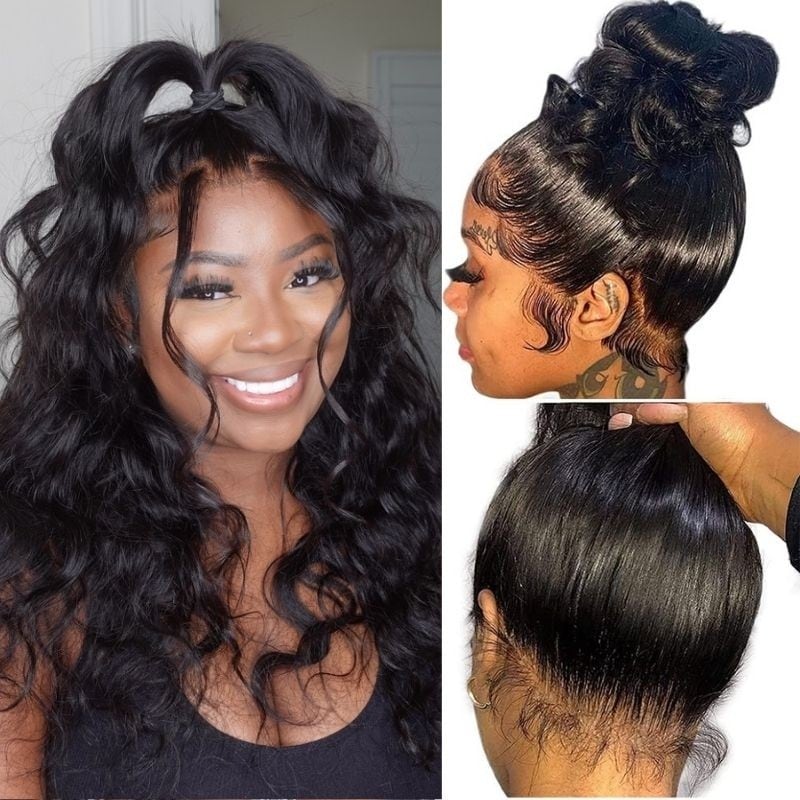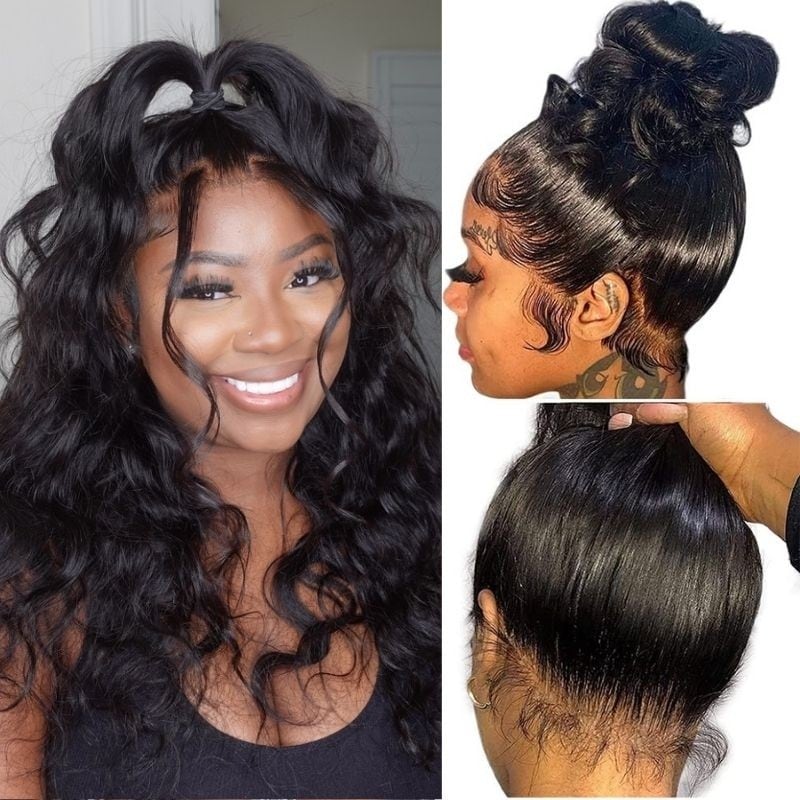Have you ever wondered how often you should get your human hair wig professionally serviced? Well, you’re in luck because in this article, we’ll delve into the topic in detail and provide you with all the information you need. Human hair wigs are a fantastic innovation, offering endless possibilities for styling and catering to those with hair loss or a desire for a new look. These wigs are crafted from real human hair and are known for their natural appearance and versatility.
Human hair wigs are incredibly durable and can last longer than synthetic wigs if properly maintained. While the initial investment may be higher, the value they offer in the long run makes it worthwhile. You can care for them just like your own hair, with regular shampooing and conditioning to keep them looking their best.
One of the significant advantages of human hair wigs is their comfort. They are gentle on the scalp, making them suitable for individuals with sensitive skin or undergoing treatments causing hair loss. With various cap sizes available, you can easily find a snug and secure fit, enhancing overall comfort.
In the world of human hair wigs, there are various types and options to choose from, catering to different textures, lengths, and colors. You can also experiment with different installation methods, from sewn-in to glued or clipped. Not only do human hair wigs offer solutions for hair loss, but they also provide a no-commitment way to change your hairstyle, color, or length without damaging your natural hair.
So, how often should you get your human hair wig professionally serviced? Make sure to read our article to find out more about caring for your wig and keeping it in great condition.

Factors Influencing Wig Servicing
Wig Quality and Durability
The quality and durability of a wig play a significant role in determining its service schedule. Higher-quality wigs, such as those made from Remy human hair, tend to be more durable and long-lasting. These wigs are made from hair strands carefully selected and aligned in the same direction, ensuring a natural and seamless look. On the other hand, lower-quality wigs may require more frequent servicing as they are more prone to tangling, shedding, and losing their shape over time.
Frequency of Wear
The frequency at which a wig is worn also affects its servicing needs. Wigs that are worn daily, especially by individuals with hair loss or undergoing treatments, may require more frequent servicing to maintain their appearance and condition. Wigs that are only worn on special occasions or infrequently may not need professional servicing as often, but regular maintenance is still essential to keep them in good shape.
Environmental Factors
The environment in which a wig is worn can have an impact on its servicing requirements. Exposure to factors such as sunlight, humidity, and pollution can cause the hair strands to become dry, frizzy, or faded. Individuals living in hot and humid climates or those who spend a lot of time outdoors may need to service their wigs more often to combat these environmental effects.
Styling and Maintenance Habits
Individual styling and maintenance habits also contribute to the frequency of professional wig servicing. Regular use of heat styling tools, such as straighteners or curling irons, can cause damage to the hair strands over time, resulting in the need for repairs or replacements. Proper brushing, detangling, and storage practices can help prolong the lifespan of a wig and reduce the need for frequent professional servicing.
Determining the Service Schedule
Manufacturer’s Recommendations
When it comes to determining how often a human hair wig should be professionally serviced, the manufacturer’s recommendations are a good starting point. Wig manufacturers typically provide guidelines on how often their wigs should be serviced to maintain their quality and appearance. Following these recommendations can help ensure that the wig remains in optimal condition.
Personal Preference
Personal preference also plays a role in determining the service schedule for a wig. Some individuals may prefer to have their wig professionally serviced more frequently to ensure that it always looks its best. Others may choose to extend the time between services based on their personal needs and budget. It is important to find a balance that meets both personal preferences and the wig’s maintenance requirements.
Wig Condition and Appearance
The condition and appearance of the wig are important factors to consider when determining the service schedule. Signs such as loss of shine, tangling, or matting indicate that the wig may need professional attention. Regular inspections of the wig’s condition can help identify when servicing is necessary and prevent any further damage or deterioration.
Comfort and Fit
Lastly, the comfort and fit of the wig can also influence the service schedule. If the wig becomes loose, uncomfortable, or starts to cause irritation, it may be time for professional servicing. Proper adjustments, repairs, or replacements can be made during the service to ensure that the wig fits securely and comfortably on the wearer’s head.

Importance of Professional Servicing
Preserving Wig Quality
One of the primary reasons for regular professional wig servicing is to preserve the quality of the wig. Professional wig technicians have the expertise and specialized tools to clean, condition, and maintain the wig correctly. This helps to prevent damage, such as tangling, shedding, or breakage, which can occur with improper maintenance techniques.
Extending Lifespan
Regular professional servicing can significantly extend the lifespan of a human hair wig. By addressing issues such as loose or missing wefts, damaged strands, or frizzy textures, professional technicians can restore the wig to its original condition. This not only saves the wearer from the expense of purchasing a new wig but also allows them to enjoy their favorite wig for a longer period.
Maintaining Style Integrity
Human hair wigs are known for their ability to hold various styles, from straight to curly to wavy. However, over time, styling products, heat, and wear can cause the wig’s style to lose its integrity. Professional wig servicing includes restyling and rejuvenating techniques that can bring the wig back to life and restore its original style and appearance.
Identifying and Addressing Issues
A professional wig servicing appointment provides an opportunity to have the wig thoroughly inspected for any underlying issues that may not be visible to the wearer. This can include identifying areas of weakness, damage, or wear and tear that may worsen over time if left untreated. By addressing these issues early on, the wearer can avoid more significant problems and ensure the longevity of their wig.
Recommended Frequency of Servicing
General Guideline
As a general guideline, it is recommended to have a human hair wig professionally serviced every 6 to 8 weeks. This timeframe allows for regular maintenance and inspections to keep the wig in optimal condition. However, it is important to note that individual factors such as the factors mentioned above and personal preference should be taken into consideration when determining the frequency of servicing.
Everyday Wear
For individuals who wear their wig every day, such as those with hair loss or undergoing treatments, more frequent professional servicing may be necessary. A monthly service schedule can help ensure that the wig remains clean, conditioned, and comfortable to wear, as daily use can subject the wig to more sweat, oils, and residues.
Occasional Wear
For individuals who wear their wig on occasion or only for special events, a service schedule of every 2 to 3 months may be sufficient. However, it is still important to maintain regular DIY maintenance practices to keep the wig in good condition between professional services.
Special Occasions
When preparing for a specific event or occasion, it is recommended to have the wig professionally serviced a few days or a week in advance. This allows the wig technician to ensure that the wig is in perfect condition, styled to the wearer’s preference, and ready to be worn with confidence.

Signs that a Wig Needs Professional Servicing
Loss of Shine and Luster
If a human hair wig starts to lose its shine and luster, it may be a sign that it needs professional servicing. Over time, exposure to external factors and product buildup can dull the hair strands, making the wig appear lifeless or faded. Professional cleaning and conditioning techniques can restore the wig’s shine and luster, giving it a fresh and vibrant look.
Tangled or Matted Hair
Tangled or matted hair is a common issue with human hair wigs, especially if proper care and maintenance practices are not followed. If the wig becomes difficult to brush or comb through, or if individual hair strands start to stick together, it may be time for professional detangling and conditioning. Attempting to detangle the hair strands without professional assistance can lead to further damage or breakage.
Loose or Missing Wefts
Human hair wigs are constructed with wefts, which are small bundles of hair strands sewn onto the wig cap. Over time, these wefts may become loose or even detach from the cap, resulting in thinning areas or bald spots on the wig. This is a clear sign that the wig needs professional servicing to repair or replace the damaged wefts and restore the wig’s fullness.
Notable Changes in Comfort
If a human hair wig starts to feel uncomfortable or causes irritation on the scalp, it is important to address the issue promptly. Changes in comfort can indicate problems such as a loosened cap, stretched elastic, or damaged hair strands touching the scalp. A professional wig servicing appointment can help identify and resolve these issues, ensuring that the wig fits securely and comfortably.
Steps Involved in Professional Wig Servicing
Thorough Cleaning
The first step in professional wig servicing is a thorough cleaning process. This involves using specialized wig shampoos and conditioners to gently cleanse the wig and remove any dirt, sweat, oils, or product buildup. The wig is soaked in a basin of lukewarm water mixed with the shampoo, then rinsed and gently squeezed to remove excess water.
Conditioning and Moisturizing
After cleaning, the wig undergoes a conditioning and moisturizing treatment to restore its softness and hydration. A deep conditioner is applied to the wig strands, focusing on the mid-lengths to ends, and left on for a specified period. This helps to replenish moisture, reduce frizz, and improve the overall texture and manageability of the wig.
Repairing or Replacing Damaged Wefts
If the wig has any loose or missing wefts, the professional technician will carefully inspect the wig and determine the best course of action. This may involve re-sewing loose wefts back into place or replacing damaged wefts with new ones. This step ensures the wig’s structural integrity and prevents further hair loss or thinning.
Restyling and Rejuvenating
Once the cleaning, conditioning, and repair processes are complete, the wig may be restyled and rejuvenated to bring back its original appearance or create a new look. This can involve cutting, trimming, or reshaping the wig to match the wearer’s desired style. Heat styling tools may be used, such as straighteners or curling irons, to create different textures and looks.

Choosing a Professional Wig Servicing Provider
Experience and Expertise
When selecting a professional wig servicing provider, it is essential to consider their experience and expertise in working with human hair wigs. Look for technicians who have specialized training or certification in wig servicing to ensure that they have the necessary skills and knowledge to handle your wig with care.
Customer Reviews and Recommendations
Reading customer reviews and recommendations can provide valuable insights into the quality of service provided by a wig servicing provider. Look for positive reviews and testimonials from satisfied customers who have had their wigs serviced by the provider. This can help give you confidence in their ability to meet your needs and provide excellent customer service.
Communication and Consultation
A reputable wig servicing provider should offer clear and open communication channels for clients. They should be willing to answer any questions or concerns you may have and provide detailed information about their service process. A consultation appointment before the actual servicing can help ensure that both parties have a clear understanding of your expectations and the desired outcome.
Pricing and Packages
Pricing is another important consideration when choosing a professional wig servicing provider. While it is natural to want to find the most affordable option, it is also crucial to prioritize quality and expertise. Look for providers that offer transparent pricing and consider the overall value of the service in terms of the quality of work and peace of mind it provides.
DIY Wig Maintenance Between Professional Services
Regular Shampooing and Conditioning
Regular shampooing and conditioning are essential for maintaining the cleanliness and freshness of a human hair wig between professional services. Use a mild shampoo specifically formulated for wigs to gently cleanse the strands and remove any buildup. Follow with a lightweight conditioner designed for human hair wigs to restore moisture and prevent tangling.
Careful Brushing and Detangling
Proper brushing and detangling techniques can help prevent unnecessary damage to the wig. Use a wide-toothed comb or a wig brush with gentle bristles to carefully brush through the strands, starting from the ends and working your way up. Avoid tugging or pulling on the wig, as this can lead to breakage or hair loss.
Storing and Protecting the Wig
Proper storage and protection are crucial to maintaining the wig’s shape and preventing damage. When not in use, store the wig on a wig stand or in a wig box to preserve its style and prevent tangling. Avoid storing the wig in direct sunlight or in hot, humid environments, as this can cause the hair strands to frizz or become dry.
Avoiding Heat and Chemical Damage
Excessive heat and chemical exposure can damage human hair wigs, causing them to become dry, brittle, or faded. Avoid exposing the wig to high temperatures from sun exposure or hot styling tools whenever possible. If heat styling is necessary, use a heat protectant spray and lower heat settings to minimize damage.

Special Considerations for Heat-Styling Wigs
Using Heat Tools Safely
When heat styling a human hair wig, it is crucial to use the proper tools and techniques to prevent damage. Use heat tools that are specifically designed for wigs or have adjustable temperature settings to avoid excessively high heat. Always use a heat protectant spray before applying any heat to the wig strands.
Choosing Heat-Friendly Products
Using heat-friendly products can help protect the wig from the damaging effects of heat styling. Look for styling products that are specifically formulated for use with human hair wigs and offer heat protection properties. These products help to minimize heat damage and keep the hair strands looking and feeling healthy.
Importance of Heat Protectants
Applying a heat protectant spray before using any heat styling tools is essential to shield the hair strands from excessive heat. Heat protectants create a barrier between the wig and the heat source, reducing the risk of damage and helping to maintain the wig’s integrity. Spray the protectant onto the wig strands, focusing on the mid-lengths to ends, before styling.
Limiting Heat Exposure
Limiting the amount of heat exposure the wig receives can help preserve its quality and prevent damage. Whenever possible, opt for heat-free styling techniques, such as wet setting or air drying, to achieve desired styles. Reserve heat styling for special occasions or when necessary and always use the lowest heat setting that achieves the desired results.
Tips for Prolonging Wig Lifespan
Proper Storage and Handling
Proper storage and handling practices can significantly prolong the lifespan of a human hair wig. When not in use, store the wig on a wig stand or in a wig box to maintain its shape and prevent tangling. Avoid pulling or tugging on the wig during styling or removal, as this can cause damage to the hair strands or the wig cap.
Avoiding Exposure to Harsh Elements
Exposure to harsh elements such as strong sunlight, chlorine, saltwater, or excessive humidity can damage a human hair wig. If possible, avoid wearing the wig in environments where it may be exposed to these elements for extended periods. When necessary, use protective products such as UV-protective sprays or swim caps to minimize damage.
Gentle and Careful Styling
Gentle and careful styling techniques can help prevent unnecessary damage to the wig. Avoid using excessive force or tension when styling the wig, as this can cause breakage or hair loss. Opt for gentle combing or finger styling techniques and avoid tight or stressful hairstyles that may pull on the wig strands.
Avoiding Excessive Tension and Pulling
Excessive tension or pulling on the wig can weaken the hair strands and cause breakage. Avoid using overly tight hair accessories or hairstyles that require excessive pulling or tension on the wig. Opt for looser or more relaxed styles that allow the wig to move naturally and freely.
Common Mistakes to Avoid in Wig Maintenance
Using the Wrong Products
Using the wrong products on a human hair wig can cause significant damage. Avoid using regular hair care products or those designed for synthetic wigs on human hair wigs, as they may contain ingredients that are too harsh or not suitable for human hair. Invest in high-quality, wig-specific products that are gentle and nourishing for optimal maintenance.
Improper Washing Techniques
Improper washing techniques can lead to tangling, matting, or loss of hair strands in a human hair wig. Avoid scrubbing or rubbing the wig vigorously during the washing process, as this can cause damage to the cuticles and result in tangling. Instead, gently squeeze and pat the wig dry, avoiding any rubbing or squeezing motions.
Neglecting the Wig Cap
The wig cap is a crucial component of a human hair wig and plays a significant role in its fit, comfort, and overall appearance. Neglecting the wig cap can lead to discomfort, irritation, or a poor-fitting wig. Regularly clean the wig cap to remove oils and residues, and ensure that it is properly adjusted and secured for a comfortable and secure fit.
Skipping Regular Maintenance
Skipping regular maintenance practices can lead to a decline in the quality and appearance of a human hair wig. Regularly shampooing, conditioning, and detangling the wig are essential for keeping it in good condition between professional servicing. Neglecting these maintenance practices can result in tangling, matting, frizz, or a dull appearance.
Consulting a Wig Specialist
Seeking Professional Advice
If you have any concerns or questions about the maintenance of your human hair wig, it is always best to seek professional advice. A wig specialist or technician can assess the condition of your wig, provide personalized recommendations, and address any specific issues or concerns you may have. They can guide you on the best practices for maintaining your wig’s quality and appearance.
Customized Servicing Plans
A wig specialist can help create a customized servicing plan for your human hair wig based on its specific needs and your lifestyle. This can include recommendations for professional servicing frequency, DIY maintenance practices, styling techniques, and product selection. A customized plan ensures that you are providing the best care for your wig and optimizing its lifespan.
Evaluation and Recommendations
During a consultation or professional servicing appointment, a wig specialist can evaluate the condition of your wig and provide recommendations for any necessary repairs, restyling, or rejuvenation. They can discuss any underlying issues they may have identified and guide you on the best course of action to ensure the longevity and quality of your wig.
Tips for Wig Care
A wig specialist can offer valuable tips and advice for maintaining your human hair wig and addressing common concerns or issues. This can include tips for styling, brushing, detangling, proper storage, protecting against heat or environmental damage, and more. Their expertise and experience can be invaluable in helping you achieve the best results from your wig.
Conclusion
In conclusion, professional servicing plays a crucial role in maintaining the quality, appearance, and lifespan of a human hair wig. The frequency of servicing should be determined based on factors such as wig quality, frequency of wear, environmental factors, and personal preference. Professional wig servicing helps preserve the wig’s quality, extend its lifespan, maintain style integrity, and address any underlying issues. Regular DIY maintenance practices, such as shampooing, conditioning, careful brushing, and proper storage, are also essential in between professional servicing appointments. Consulting a wig specialist can provide personalized advice and guidance for the care of your human hair wig, ensuring that you enjoy its beauty, comfort, and versatility for as long as possible.
